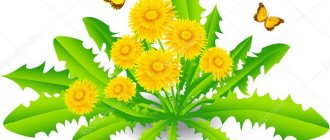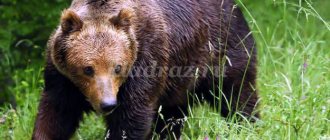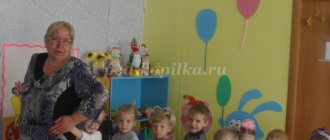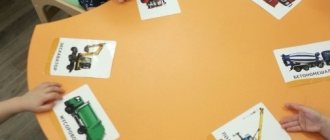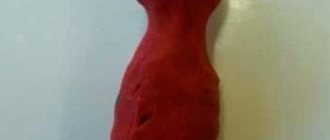Thematic lesson “Turnip” for 1.5-2 years
The fairy tale "Turnip" is one of the first children's books that parents begin to read to their baby. It’s more likely not to read, but to tell the story from the pictures. To make a child love and remember this story, you can play with the fairy tale from different angles. That's what we tried to do with our one and a half year old baby.
Games on flannelgraph
We also made a flannelgraph for our older child. The heroes of the fairy tale “Turnip” have still been preserved, although a little with the patina of time. However, this did not make them any less interesting for the younger one. First, we got to know the characters and simply learned how to attach them to a flannelgraph. A little later they were already trying to arrange the characters in the right order. True, my son prefers to immediately place the mouse after his grandfather. In the end, we managed to place everyone in the right order.
Studying the sizes
At this stage we teach the concepts of big, small, medium. They attached them to turnips. The child seated the bears and fed them turnips of the appropriate size: a large bear - a large turnip, a medium one - a medium one, a small one - a small one.
They also laid out the turnips from smallest to largest. This is how our turnips grew.
Find the outline
We selected the appropriate contours for the turnips.
Games with clothespins For the game, we prepared a turnip without tops and green clothespins. The clothespins are not tight and can be easily opened by a child.
Playing with mosaics
For the game, we printed out the turnip coloring page on an A4 sheet of paper and colored it in the required colors. The sheet was placed on the board and several holes were made so that the child could see where the chips should be inserted. The task is to arrange the chips by color (make the tops green, turnips yellow).
Who eats what?
They fed the heroes of the fairy tale. At the same time, they reinforced that the mouse loves cheese, the cat loves fish, and the dog loves bones.
We are building a house
A house for the woman and grandfather was made from geometric shapes.
Let's play with the ball
We pass the turnip ball to each other. Mom says - the turnip is sweet, round, yellow, tasty. We learn to throw a ball and catch it.
Developing motor skills
We played with cereals and planted turnips in the garden bed. At the same time, we talked about what else was growing in the garden - we planted carrots, peas, and eggplant. We tried to lay out an even path with beans, but it didn’t last long.
They sculpted turnips from plasticine, rolled sausages, and made beds out of them. Various vegetables and our turnips were planted in them.
They cooked porridge for the woman and grandfather in a toy saucepan and spooned it onto plates.
They fed the mouse buttons. A picture of a mouse was glued to the box and a hole was made - a mouth for it. I made the hole specially small so that small buttons could fit. We talked about sizes and saw that large buttons did not fit here.
We string beads onto a cord and make a gift for our granddaughter.
Creation
They made a torn applique and decorated a turnip. Lately my son has become interested in this, which makes me very happy. He applies the glue stick so diligently!
Of course, this theme can be further developed by adding other games and making them more complex. We are still small and can only cope with these tasks. Let me give you an example of what you can still do after 2 years:
- Gather vegetables – Place a variety of vegetables on the floor in front of your child. Ask him to give you the vegetable as described.
- Study the structure of turnips.
- Find captions for pictures of heroes
- Play logic games - continue the series, find a pair, etc.
Progress of the lesson:
The teacher tells the children that today a dog, a cat and a mouse came to visit them. Shows the toys and asks the children:
- How does the dog scream? (Woof woof woof)
.
- How does a cat scream? (Meow meow meow)
.
- How does a mouse scream? (wee-wee-wee)
.
After the children answer, he offers them another version of onomatopoeia (yap-yap-yap, purr-purr)
. Choral and individual responses.
The teacher tells the children that the dog, cat and mouse are lost and cannot find their fairy tale , offers to help them and asks a riddle:
Grandma, old grandfather and granddaughter,
Together everyone made me
Pull it out of the ground.
(turnip)
Draws children's attention to the tabletop theater. Shows it to the children, asking them to repeat individual words and phrases.
After the theater show he asks the children:
— Why did grandfather, grandmother and granddaughter go to the garden? First he shows the grain that the grandfather planted, and then a dummy of a large turnip that has grown and offers to name its color and shape.
- Why couldn’t grandfather pull out the turnip ? When was he able to get her out? (When everyone did one thing together and helped each other)
.
Talks about the healing properties of turnips:
— The juice that can be extracted from turnips has many healing properties. So, our grandmothers also knew that if you squeeze the juice out of a turnip, it can be used to treat colds, and to recover from poisoning, and to quickly heal a wound.
Turnip is not a simple vegetable,
But a little bitter.
Treats throats for guys
It helps adults too
And it bears fruit in the fall.
That as a doctor we are growing.
Sensory education of toddlers through didactic games JV “Kindergarten “Planet of Childhood” GBOU Secondary School No. 7 of the city of Pokhvistnevo Consultation on the topic: “Sensory education of toddlers.
"Radiant sunshine." Lesson summary in an early age group Topic: “Radiant Sun” Goal: formation of an active vocabulary in children through the organization of different types of activities: cognitive, playful.
Consultation for parents “Adaptation of toddlers in a preschool institution” A kindergarten is the first social institution a child encounters. Social in the sense that the child is meeting for the first time.
Summary of the game lesson “How they woke up the sun” (second group of early age) Objectives: For visual activities: (non-traditional technique). 1. Arouse interest in obtaining an image using the “print” method.
Summary of the game-activity in the first group of young children “The sun is shining” Theme “The sun is shining” Program content: Teach children to depict the sun, using the print of their palm, to pronounce the words of the chant.
Summary of a summer walk in the middle group “Sunny, sunshine, shine a little!” Summary of a summer walk in middle group No. 8 “Luchiki” MADOU “Teremok” AGO. Educator: Pilgrimova Polina Nikolaevna “Sunshine, sunshine.”
Summary of creative work on modeling in the second group of early age “Sun-Bell” Purpose: to teach basic modeling techniques: rolling, pressing, pulling. Learn to depict the basic shape of an object (a ball, highlight it.
Self-education report “Sensory development of toddlers” The age from 2 to 3 years is important in the development of a child’s psyche. During this period, the foundation is laid for the formation of new mental formations.
New Year's holiday scenario for toddlers Santa Claus comes to the children's group. Father Frost. Hello kids! Hello parents! I am a cheerful Santa Claus, your New Year's Guest.
Lesson summary for the junior group “Magic Sun” Magic Sun Tasks. Learn to examine an object, highlight its shape, be able to correlate an object by type, and develop color perception. Develop.
Source
Game activity in the nursery group of a kindergarten (for children of the third year of life), topic: “Turnip”
Author of the lesson: Davydova Svetlana Alekseevna.
Arouse interest in the fairy tale “Turnip”. Learn to count like an adult. To form stable ideas about the concepts of “big-small”, “top”, “din-many”, “first-then”. Learn to play the role of a fairy tale character with the help of an adult. Reinforce knowledge about yellow and green colors. Introduce words with diminutive suffixes into the children's dictionary. Continue teaching children to draw with crayons and sculpt with salt dough. Develop in children the ability to listen carefully. Develop attention, speech, sense of rhythm, fine motor skills, coordination of movements. Cultivate friendships with peers.
Equipment:
Characters for the table theater "Turnip". Salty dough. Turnip silhouettes. Cardboard silhouettes of turnips with green tops, trays in yellow and green. Cardboard large and small “turnips” and “baskets”. Board. Crayons. Coloring pictures “Turnip”, green and yellow wax crayons. A large yellow ball with green corrugated paper tops attached. Umbrella. Doll dishes (pots, plates, spoons), napkins, cereals. Audio recording of the song “Friendship”. Diamonds. Attributes for staging a fairy tale: hat, scarf, apron, “Dog”, “Cat”, “Mouse” hats.
